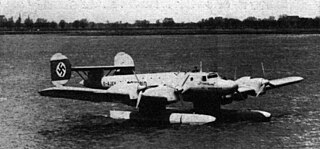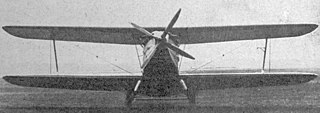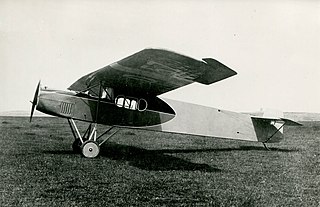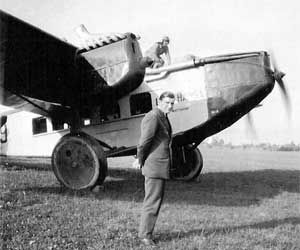
The Junkers G.38 was a large German four-engined transport aircraft which first flew in 1929. Two examples were constructed in Germany. Both aircraft flew as a commercial transport within Europe in the years leading up to World War II.

The Junkers F 13 was the world's first all-metal transport aircraft, developed in Germany at the end of World War I. It was an advanced cantilever-wing monoplane, with enclosed accommodation for four passengers. 322 planes of the type were manufactured, an exceptionally large number for a commercial airliner of the era, and were operated all over the globe. It was in production for thirteen years and in commercial service for more than thirty.

The Dornier Do X was the largest, heaviest, and most powerful flying boat in the world when it was produced by the Dornier company of Germany in 1929. First conceived by Claude Dornier in 1924, planning started in late 1925 and after over 240,000 work-hours it was completed in June 1929.

The Blohm & Voss Ha 139 was a German all-metal inverted gull wing floatplane. With its four engines it was at the time one of the largest float-equipped seaplanes that had been built. The inboard engines were mounted at the joint between the inboard anhedral and outboard dihedral wing sections, above the pylon-mounted floats.

The Siebel Si 204 was a small twin-engined transport and trainer aircraft developed in World War II. It was based on the Fh 104 Hallore. Originally designed in response to an Ministry of Aviation development order for a small civil transport aircraft in 1938, it was eventually produced for the Luftwaffe.

The Junkers G 24 was a German three-engine, all-metal low-wing monoplane passenger aircraft manufactured by Junkers from 1925. Junkers F 24 was the designation for single-engine versions of the same aircraft.

The Albatros L 73 was a German twin-engined biplane airliner of the 1920s. Of conventional configuration, it featured a streamlined, boat-like fuselage and engine nacelles. All four manufactured aircraft of that type were operated by Deutsche Luft Hansa, one of which crashed near Babekuhl on 28 May 1928.

The Arado S I was a biplane trainer built in Germany in 1925. The first of three prototypes was powered by a Bristol Lucifer radial engine, while the other two Arado S.Ia aircraft were fitted with the Siemens-Halske Sh 12. The Siemens-Halske Sh 11 powered the Arado S III, a virtually identical aircraft of which only a single prototype was constructed and sold to Turkey.
The Arado SC II was a biplane trainer, developed in Germany in the 1920s. It was based heavily on the SC I, with a more powerful BMW Va engine. Ten examples were built for the Deutsche Verkehrsfliegerschule.

The Caspar C 35 Priwall was a German airliner of the late 1920s, of which only a single example was built. It was a large, single-engine, single-bay biplane of conventional configuration with fixed tailskid undercarriage. The staggered, equal-span wings were braced with a large I-strut. Not only were the passengers seated within a fully enclosed cabin, but the flight deck was fully enclosed as well.

The BFW M.20 was a German single-engine, high-wing monoplane ten-seat passenger transport aircraft, developed in the late 1920s and early 1930s. Deutsche Luft Hansa used it throughout the 1930s on a variety of routes.

The Dornier Do R Superwal was a German flying boat airliner of the 1920s.

The Fokker F.III was a single-engined high-winged monoplane aircraft produced in the 1920s by the Dutch aircraft manufacturer Fokker. It could carry five passengers. The aircraft was also built under licence in Germany as the Fokker-Grulich F.III.

The Focke-Wulf A 17 Möwe was an airliner built in Germany in the late 1920s. It was a conventional high-wing cantilever monoplane with fixed tailwheel undercarriage. The aircraft provided fully enclosed seating for up to eight passengers and had a separate, fully enclosed flight deck for the two pilots. Most examples flew with Deutsche Luft Hansa, serving until around 1936. In the early 1930s, two A 17s were used for testing the Junkers Jumo 5 diesel engine.

The Fokker F.II was the first of a long series of commercial aircraft from the Fokker Aircraft Company, flying in 1919. In a biplane age, it presented a distinct clean, high-wing monoplane style that sold successfully across Europe and North America during the development of commercial passenger-carrying aviation.

The Rohrbach Ro X Romar was a German long-range commercial flying-boat and the last aircraft designed and built by Rohrbach Metall Flugzeugbau GmbH.

The Heinkel HD 39 was a special-purpose cargo aircraft developed in Germany in the 1920s to distribute the Berlin newspaper B.Z.. It was a conventional single-bay biplane with staggered wings of equal span, and a fuselage that nearly filled the interplane gap. The pilot sat in an open cockpit, and the undercarriage was of fixed, tailskid type with divided main units. The sole example of the type was built after Ernst Heinkel found out, by chance, that B.Z. required such an aircraft and had ordered two machines from Albatros. Heinkel convinced publisher Ullstein-Verlag to purchase a third aircraft from his firm.

Rohrbach Ro V was a seaplane manufactured by the Rohrbach Metall-Flugzeugbau company in Berlin, Germany. Only one was built, in 1927. It was delivered to Severa GmbH for comparison flights with the Dornier Do J "Superwal" and as a seaplane trainer. It was used for commercial flights in 1928 by the Deutsche Luft Hansa for the Travemünde to Oslo route.
The Messerschmitt M 28 was a mail plane developed in Germany in the early 1930s to meet a requirement by Deutsche Luft Hansa. It was a single-engine, low-wing cantilever monoplane of conventional design with an enclosed cockpit and fixed, tailskid undercarriage.

The Rohrbach Ro VIII Roland was an airliner produced in Germany during the 1920s. It was a conventional strut-braced, high-wing monoplane, based loosely on the Zeppelin-Staaken E-4/20 that Adolf Rohrbach designed in 1920. It had a fully enclosed flight deck and passenger cabin, and featured fixed, tailskid undercarriage. Power was supplied by three engines, one in the nose, and two mounted in nacelles on the wings. Construction was of metal throughout.


















